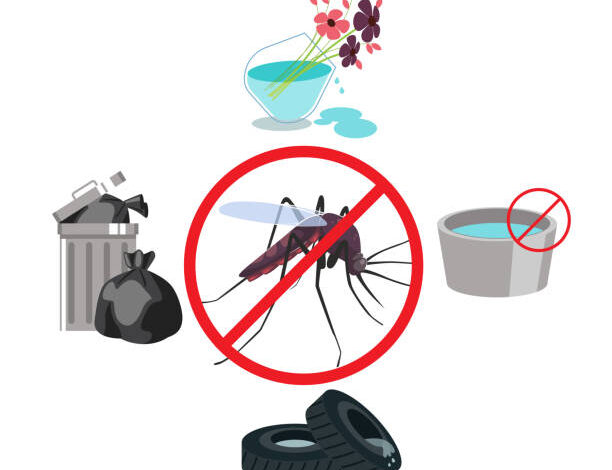Dengue fever, a mosquito-borne viral illness, poses a significant public health challenge in many parts of the world, particularly in tropical and subtropical regions. Characterized by the sudden onset of high fever, severe headache, joint and muscle pain, and rash, dengue fever can range from mild to severe, and in some cases, can be life-threatening. Understanding the causes, symptoms, prevention, and treatment of dengue fever is crucial in combating its spread and minimizing its impact on affected communities.

The Culprit: Dengue Virus
The Dengue virus (DENV), a member of the Flaviviridae family, is the causative agent behind Dengue fever, a mosquito-borne viral illness prevalent in tropical and subtropical regions worldwide. This single-stranded RNA virus is primarily transmitted to humans through the bite of infected Aedes mosquitoes, notably Aedes aegypti and Aedes albopictus. Dengue virus infection can manifest in a spectrum of clinical presentations, ranging from mild flu-like symptoms to severe and potentially life-threatening complications such as Dengue Hemorrhagic Fever (DHF) and Dengue Shock Syndrome (DSS). Understanding the biology and transmission dynamics of the Dengue virus is crucial in developing effective prevention and control strategies to combat the spread of this significant public health threat.
Symptoms and Clinical Manifestations
dengue fever symptoms and clinical manifestations can vary widely depending on the individual’s immune response, age, and other factors. Typically, the onset of symptoms occurs 4 to 10 days after being bitten by an infected mosquito. The following details the range of symptoms commonly associated with dengue fever:
High Fever:
Dengue fever often begins with a sudden onset of high fever, which can reach up to 104°F (40°C). This fever is usually abrupt and may last for 2 to 7 days.
Severe Headache:
Many individuals with dengue fever experience intense headaches, often described as a severe throbbing pain behind the eyes or in the temples. This symptom is sometimes referred to as a “breakbone” fever due to its severity.
Muscle and Joint Pain:
Dengue fever is characterized by significant muscle and joint pain, known as myalgia and arthralgia, respectively. This pain can be widespread and severe, affecting multiple joints and muscle groups throughout the body.
Rash:
A characteristic skin dengue fever rash may develop in some cases, typically appearing around the time of defervescence (when the fever begins to subside). The rash is often maculopapular (red spots or bumps) and may be accompanied by itching.
Nausea and Vomiting:
Many individuals with dengue fever experience gastrointestinal symptoms such as nausea and vomiting, which can contribute to dehydration if not adequately managed.
Pain Behind the Eyes:
Dengue fever can cause significant discomfort in the eyes, with pain often exacerbated by eye movements. This symptom, known as retro-orbital pain, is commonly reported by patients.
Mild Bleeding Manifestations:
Some individuals may experience mild bleeding manifestations, such as nosebleeds (epistaxis), bleeding gums, or easy bruising. These symptoms typically result from the effects of the virus on blood vessels and platelet function.
Other Symptoms:
Additional symptoms of dengue fever may include fatigue, weakness, abdominal pain, swollen lymph nodes (lymphadenopathy), and respiratory symptoms such as cough.
While the majority of dengue fever cases resolve on their own with supportive care, a small proportion of individuals may develop severe complications, including Dengue Hemorrhagic Fever (DHF) or Dengue Shock Syndrome (DSS). Symptoms of severe dengue may include severe abdominal pain, persistent vomiting, rapid breathing, bleeding from the gums or nose, and signs of shock such as cold and clammy skin, weak pulse, and low blood pressure. Prompt medical attention is essential for individuals exhibiting signs of severe dengue, as these complications can be life-threatening if not treated promptly.
Overall, recognizing the diverse array of symptoms associated with dengue fever is critical for early diagnosis and appropriate management, thereby reducing the risk of complications and improving outcomes for affected individuals.

Diagnosis and Laboratory Testing
Diagnosing dengue fever relies on a combination of clinical assessment and laboratory testing, given the nonspecific nature of its symptoms. Healthcare providers typically consider the patient’s clinical presentation, medical history, travel history to dengue-endemic areas, and the presence of known risk factors such as recent mosquito bites. However, laboratory testing is essential for confirming the diagnosis and distinguishing dengue fever from other febrile illnesses.
Several laboratory tests are available to aid in the diagnosis of dengue fever:
Enzyme-Linked Immunosorbent Assay (ELISA):
ELISA tests detect the presence of dengue-specific antibodies (IgM and IgG) in the patient’s blood serum. IgM antibodies are typically detectable within the first week of illness, while IgG antibodies may persist for months to years after infection. A rising IgG antibody titer between acute and convalescent-phase samples can also provide diagnostic confirmation.
Polymerase Chain Reaction (PCR):
PCR assays detect viral RNA in the patient’s blood, providing a rapid and sensitive method for diagnosing acute dengue infection, especially during the early stages of illness. PCR tests can identify the serotype of the dengue virus, which is crucial for epidemiological surveillance and outbreak investigations.
NS1 Antigen Test:
The NS1 antigen test detects the presence of the dengue virus non-structural protein 1 (NS1) in the patient’s blood during the acute phase of infection. NS1 antigenemia is typically detectable within the first few days of illness and can help confirm acute dengue infection.
Virus Isolation:
Virus isolation involves culturing the dengue virus from the patient’s blood or other clinical specimens, such as serum or plasma. While virus isolation is considered the gold standard for diagnosing dengue fever, it is time-consuming and requires specialized laboratory facilities, limiting its utility in routine clinical practice.
Hematological and Biochemical Tests:
Complete blood count (CBC) may reveal leukopenia (low white blood cell count) and thrombocytopenia (low platelet count), which are common laboratory findings in dengue fever. Additionally, liver function tests (e.g., alanine aminotransferase, aspartate aminotransferase) may show elevated levels in patients with severe dengue.
It is important to note that laboratory test results should be interpreted in conjunction with the patient’s clinical presentation and epidemiological context. False-negative results may occur, particularly if the patient is tested during the early or late stages of illness when viral load is low. Repeat testing may be necessary in suspected cases with negative initial results.

Preventing dengue fever relies on comprehensive strategies aimed at reducing mosquito populations and minimizing human-mosquito contact. Given that the Aedes mosquitoes responsible for transmitting the dengue virus breed in and around human dwellings, community-based efforts are essential for effective prevention. The following are key prevention strategies:
Mosquito Control:
Eliminating mosquito breeding sites is fundamental to dengue prevention. Community members should be educated about the importance of regularly emptying, covering, or treating containers that can collect water, such as flower pots, tires, buckets, and water storage containers. Environmental management techniques, such as proper solid waste disposal and drainage of stagnant water, can also help reduce mosquito breeding habitats.
Vector Surveillance:
Monitoring mosquito populations and their infection rates through vector surveillance programs is crucial for early detection of dengue virus transmission and targeted control interventions. This involves collecting and analyzing mosquito specimens to assess population dynamics, species distribution, and virus prevalence.
Personal Protection Measures:
Individuals can protect themselves from mosquito bites by using insect repellents containing DEET, picaridin, or oil of lemon eucalyptus, applying them to exposed skin and clothing. Wearing long-sleeved shirts, long pants, and socks can also help minimize skin exposure to mosquitoes, especially during peak biting times (dawn and dusk). Additionally, using mosquito nets while sleeping, particularly for infants and young children, can provide added protection.
Community Engagement and Education:
Public awareness campaigns play a vital role in promoting dengue prevention behaviors and fostering community participation in vector control activities. Educational initiatives should emphasize the importance of eliminating mosquito breeding sites, using personal protective measures, and seeking medical care promptly for suspected dengue fever symptoms. Targeted messaging tailored to specific population groups, including schools, households, and workplaces, can enhance community engagement and compliance with preventive measures.
Integrated Vector Management (IVM):
Implementing integrated vector management approaches that combine multiple control methods, such as larval source reduction, insecticide-treated materials, biological control agents, and community mobilization, can enhance the effectiveness and sustainability of dengue prevention efforts. IVM strategies should be tailored to local epidemiological and ecological contexts, with active involvement from stakeholders across sectors, including health, environment, and urban planning.
Water Storage and Household Hygiene:
Encouraging safe water storage practices, such as covering water containers and regularly cleaning water storage vessels, can help prevent mosquito breeding in and around households. Additionally, promoting proper sanitation and hygiene, including the use of screened windows and doors, can reduce indoor mosquito entry and enhance household protection.
Chemical Control:
In areas with high dengue transmission or during outbreaks, targeted application of larvicides or adulticides may be necessary to suppress mosquito populations and reduce disease transmission. However, chemical control measures should be implemented judiciously, following recommended guidelines to minimize environmental impact and prevent the development of insecticide resistance.

By implementing a combination of these prevention strategies at the individual, community, and institutional levels, stakeholders can effectively reduce the burden of dengue fever and mitigate its impact on public health. Sustainable, community-driven approaches that address social, environmental, and behavioral determinants of dengue transmission are essential for long-term success in controlling this mosquito-borne disease.
dengue fever treatment and management primarily focus on alleviating symptoms, preventing complications, and providing supportive care. While there is no specific antiviral therapy for dengue fever, early recognition of symptoms and prompt medical intervention can significantly improve outcomes. The following are key aspects of treatment and management for dengue fever:
Fluid Replacement:
Maintaining adequate hydration is critical in managing dengue fever, especially in cases of fever and vomiting, which can lead to dehydration. Oral rehydration solutions (ORS) or intravenous fluids may be administered to replace fluid losses and prevent dehydration. Close monitoring of fluid intake and output, as well as electrolyte balance, is essential, particularly in severe cases.
Fever and Pain Management:
Fever and associated symptoms such as headache, muscle pain, and joint pain can be managed with over-the-counter dengue fever medication such as acetaminophen (paracetamol). Non-steroidal anti-inflammatory drugs (NSAIDs) such as ibuprofen and aspirin should be avoided due to the risk of bleeding complications.
Monitoring for Complications:
Patients with dengue fever should be closely monitored for signs of disease progression and complications, particularly in severe cases. Clinical parameters such as temperature, blood pressure, pulse rate, respiratory rate, and urine output should be regularly assessed. Laboratory tests, including complete blood count (CBC), liver function tests, and coagulation studies, may be performed to monitor for thrombocytopenia, liver dysfunction, and coagulopathy.
Blood Transfusion:
In severe cases of dengue hemorrhagic fever (DHF) or dengue shock syndrome (DSS) characterized by severe bleeding or plasma leakage, blood transfusions may be necessary to restore blood volume and prevent organ dysfunction. Platelet transfusions may be considered in patients with severe thrombocytopenia and active bleeding, although the decision should be based on careful clinical assessment and individualized management.
Intensive Care Support:
Patients with severe dengue requiring intensive care support should be managed in specialized healthcare facilities equipped to provide advanced monitoring and interventions, including mechanical ventilation, vasopressor support, and continuous renal replacement therapy (CRRT) for renal failure. Timely recognition and management of complications such as shock, multiorgan dysfunction, and severe bleeding are essential for improving survival rates.
Patient Education and Follow-up:
Patient education plays a crucial role in dengue fever management, empowering individuals and families to recognize warning signs and seek medical attention promptly. Patients should be advised to rest, stay hydrated, and avoid medications that may exacerbate bleeding, such as NSAIDs and aspirin. Follow-up visits with healthcare providers are important to monitor recovery, address lingering symptoms, and ensure resolution of the infection.
Prevention of Mosquito Bites:
While recovering from dengue fever, patients should continue to protect themselves from mosquito bites to prevent further transmission of the virus. This includes using insect repellents, wearing protective clothing, and using mosquito nets, particularly during the daytime when Aedes mosquitoes are most active.
Research and Future Directions
Efforts to combat dengue fever continue through ongoing research initiatives aimed at developing vaccines, improving diagnostic tools, and refining vector control strategies. The development and deployment of the Dengvaxia vaccine have represented a significant advancement in dengue prevention, although its efficacy varies by serotype and population. Additionally, emerging technologies such as genetically modified mosquitoes and Wolbachia-based control methods hold promise for innovative approaches to mosquito control.

Strategies for Mitigating the Global Impact of Dengue Fever
As Dengue fever continues to be a significant global health concern, especially in regions where Aedes mosquitoes are prevalent, staying protected requires a multifaceted approach that involves both individual and community efforts. Here are some key strategies to stay protected from Dengue fever:
dengue fever mosquito Bite Prevention:
Minimize exposure to Aedes mosquitoes, the primary vectors of the Dengue virus. By using insect repellents containing DEET, picaridin, or oil of lemon eucalyptus. Apply repellent to exposed skin and clothing, especially during peak mosquito activity times, such as early morning and late afternoon. Wear long-sleeved shirts, long pants, and socks to cover exposed skin. And use mosquito nets while sleeping, particularly for infants and young children.
Eliminate Mosquito Breeding Sites:
Reduce mosquito breeding habitats by regularly emptying, and covering. Or treating containers that can collect water, such as flower pots, tires, buckets, and water storage containers. Eliminate stagnant water sources around homes and communities, including clogged drains, gutters, and discarded containers. Encourage community participation in environmental cleanup activities to remove potential breeding sites.
Promote Community Awareness and Education:
Raise awareness about Dengue fever transmission, prevention, and control measures through community-based educational campaigns. Provide information on recognizing Dengue fever symptoms, seeking prompt medical care. And implementing preventive actions, such as mosquito bite avoidance and breeding site elimination. Engage local leaders, schools, health workers, and community organizations in disseminating key messages and promoting behavior change.
Implement Integrated Vector Management (IVM):
Adopt integrated approaches to mosquito control that combine multiple strategies. Including larval source reduction, insecticide-treated materials, biological control agents, and community mobilization. Develop and implement IVM plans tailored to local epidemiological. And ecological contexts, with collaboration across sectors, including health, environment, and urban planning. Monitor mosquito populations and Dengue virus transmission. Through vector surveillance programs to guide targeted interventions.
Support Vector Control Programs:
Advocate for increased resources and support for vector control programs at the national, regional, and local levels. Strengthen capacity for mosquito surveillance, outbreak response, and community-based vector control activities through training, infrastructure development, and sustainable funding mechanisms. Foster collaboration between government agencies, non-governmental organizations, academia, and other stakeholders to coordinate Dengue control efforts and share best practices.
Monitor Dengue Transmission and Outbreaks:
Establish early warning systems for Dengue fever outbreaks. And enhance surveillance mechanisms to detect and respond to changes in disease transmission patterns. Develop protocols for rapid diagnosis, case management, and outbreak response. Including access to diagnostic testing, treatment facilities, and public health interventions. Implement real-time monitoring systems to track Dengue cases, vector abundance. And environmental risk factors, enabling timely preventive action and resource allocation.
Invest in Research and Innovation:
Support research initiatives to advance understanding of Dengue fever epidemiology, vector biology, and vaccine development. Invest in innovative technologies and interventions for mosquito control, such as genetically modified mosquitoes, Wolbachia-based strategies, and novel insecticides. Foster collaboration between scientists, policymakers, and industry partners to translate research findings into practical solutions for Dengue prevention and control.
By implementing these comprehensive strategies and fostering collaboration across sectors and communities. It is possible to mitigate the impact of Dengue fever and reduce its transmission worldwide. Staying vigilant, informed, and proactive is essential in protecting individuals and communities from this mosquito-borne disease.
Conclusion
Dengue fever remains a significant global health concern, particularly in regions where Aedes mosquitoes thrive. While progress has been made in understanding the virus and developing preventive measures. Continued efforts are needed to combat its spread and mitigate its impact on affected communities. By implementing comprehensive strategies that encompass vector control. Community engagement, and research advancements. We can strive toward a future where dengue fever is no longer a pervasive threat to public health.
Post Views: 73












Certainly! Here’s an extended version of the message: